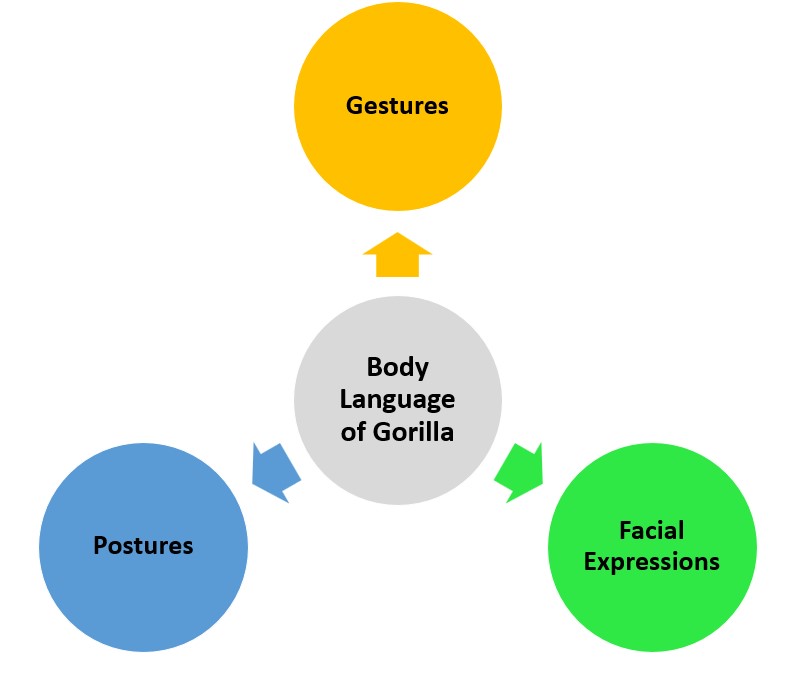.jpg)
Key Takeaways
- Gorillas have the ability to communicate with humans through various forms of non-verbal communication, such as gestures, facial expressions, and body language.
- Researchers have found that gorillas can learn and understand sign language, and can use it to express their thoughts, needs, and desires.
- The ability of gorillas to communicate with humans highlights their high level of intelligence and cognitive abilities.
- Communication between gorillas and humans can provide valuable insights into the behavior, emotions, and social dynamics of these animals.
- The study of gorilla communication can also help in conservation efforts, as understanding their needs and preferences can aid in creating better captive environments and protecting their natural habitats.
- While gorillas can communicate with humans to a certain extent, it is important to remember that they are still wild animals and should be treated with respect and caution.
Gorillas, magical creatures of the African forest, enchant us with their majesty. Can they talk to us, their distant relatives? It’s an interesting query that has stirred scientific interest. Let’s investigate the gorilla language and the chance of interspecies connection!
Gorillas express themselves mainly with vocalizations and movements. They hoot, grunt and roar to each other, showing their feelings or warning of danger. As well, they beat their chests and wave their arms.
But how can we understand them? Scientists are exploring pitch patterns in their vocalizations, and creating tech to decode their gestures. This could completely change our view of primate conversation.
Plus, exposing gorillas to human language and sign language from an early age, and building trust through positive reinforcement, could help them comprehend us – and us them!
What is Communication?
Communication is exchanging info and ideas between people and groups. It’s important for human relationships, allowing us to share our thoughts, feelings, and wishes. We can communicate verbally, with words like spoken and written language. Or, non-verbally, like with body language, gestures, and facial expressions.
- Verbal Communication: Using words to communicate.
- Non-Verbal Communication: Info exchange without words, like body language, facial expressions, and eye contact.
- Active Listening: Not just talking but comprehending others’ perspectives to improve communication.
It’s important to understand how different communication methods work together. We should also remember that effective communication is two-way. Pay attention to the responses you get as well as your own message. That way, you can adjust your communication style to connect with people from all backgrounds.
Communication Among Gorillas

Explore how gorillas use these different forms of communication to convey their needs, emotions, and intentions. Discover the intriguing ways in which gorillas communicate with each other and potentially with humans.
Vocalizations
Gorillas produce various vocalizations for different purposes. Grunts indicate greetings and affiliative behaviors, while hoots are used for reassurance and contact between group members. Barks signal potential threats or territorial challenges, and roars are mainly used by dominant males to assert their authority.
Plus, gorillas also produce other vocal signals such as screams, pants, and grumbles, each with their own specific meanings. By combining these vocalizations with their body language, gorillas communicate their intentions, emotions, and social status.
Gestures and Facial Expressions
Gestures and facial expressions are a big part of gorillas’ communication system. Here are five key points to understand this:
- Gorillas have different gestures and facial expressions to show dominance, submission, aggression, and playfulness.
- A raised arm with clenched fists is often used to show dominance. It serves as a warning sign to other group members.
- Facial expressions can mean aggression or friendliness. Teeth baring is aggressive while soft vocalizations and relaxed facial muscles indicate friendliness.
- Gorillas have special facial muscles to make a range of expressions and this helps them to communicate better.
- Gorillas can recognize themselves in reflective surfaces. This shows their understanding of their own facial expressions.
Each gorilla has its own set of gestures and expressions, making their communication style unique. This helps them to interact without depending only on vocalizations.
Koko, a leading silverback, was able to communicate using American Sign Language (ASL). This defies beliefs about non-human primate communication. Koko’s skills show the potential for understanding interspecies communication through gestures and facial expressions.
Body Language

Gorillas communicate with more than just vocalizations! Through body language, they express themselves. Let’s explore their gestures, facial expressions, and postures.
Gestures: Gorillas beat their chests to show dominance, pound the ground as a sign of aggression, raise arms with open hands to indicate submission, and slap the ground to show excitement.
Facial Expressions: They smirk for playfulness, frown when upset, have dilated eyes when scared or surprised, and narrowed eyes when concentrating or angry.
Postures: Hunched over with head lowered shows submission, while an upright stance with bristled hair displays dominance and confidence. Every gesture and posture carries specific meanings that other gorillas pick up on instinctively.
Body language is critical for maintaining social harmony among gorilla groups. Thus, it’s essential for us humans to recognize and appreciate this form of communication. So next time you observe gorillas, pay attention to every subtle movement – you may be able to unlock their secrets!
The Capacity of Gorillas to Understand Human Language
To understand the capacity of gorillas to understand human language, delve into the Studies and Research, Sign Language Communication with Gorillas, and Conversations with Gorillas. Discover the fascinating discoveries and insights gained through these sub-sections that shed light on the unique communication abilities of these incredible creatures.
Studies and Research
Studies on gorillas’ understanding of human language have uncovered amazing facts. These experiments have given us great insights into their cognitive abilities.
These findings demonstrate the gorilla’s potential to comprehend human language. To understand this better, we must look at the data and findings ourselves. Doing so, we can gain a greater appreciation for the intelligence of these primates.
Experience the exceptional capacity of gorillas to understand human language! See for yourself how they can decipher speech. Who needs words when you can just sign with a gorilla?
Sign Language Communication with Gorillas
Gorillas possess a remarkable understanding of human sign language. This cognitive talent has been researched and recorded, showing the remarkable linguistic abilities of these majestic creatures.
| Sign Language Element | Gorilla’s Response |
|---|---|
| Signing “Food” | Grabs food excitedly |
| Signing “Water” | Drinks from a bowl or cup |
| Signing “Play” | Plays joyfully |
| Signing “Hug” | Hugs caretaker tenderly |
These interactions show the incredible level of comprehension gorillas have with sign language communication. Their capability to interpret and act correctly is a reminder of their cognitive abilities.
Conversations with Gorillas
Conversations with gorillas have long intrigued scientists. They have a remarkable capacity to understand human language, prompting researchers to explore deeper. Studies and experiments have since revealed startling insights into their linguistic capabilities.
Gorillas can grasp spoken words and respond appropriately. They can even comprehend the meaning of simple phrases and commands. This breakthrough has opened up new possibilities for cross-species communication.
Moreover, gorillas can communicate using sign language. Through gestures and symbols, they express complex thoughts and emotions. This enables them to interact with humans, as well as with each other, showing their social intelligence.
Factors that Influence Communication Between Humans and Gorillas
To understand the factors that influence communication between humans and gorillas, delve into the environment and context, individual differences, and cultural influences. These sub-sections shed light on how these elements shape the interaction and understanding between these two distinct species.
Environment and Context
Communication between humans and gorillas is truly a jungle out there! But don’t worry, I’m ready to explore the individual differences.
The environment and context of communication is essential. Natural habitat or captive settings, lighting, temperature, noise levels, and the presence of other individuals or groups all affect communication.
Studies reveal gorillas possess the ability to understand human gestures and vocalizations. For example, Dr. Francine Patterson’s research at The Gorilla Foundation showed Koko’s understanding of modified American Sign Language (ASL). This study showed the potential of cross-species communication in controlled conditions.
Individual Differences
Individuals differ significantly when it comes to communication between humans and gorillas. These variations include age, gender, and social status. By exploring these distinctions, we can gain a better insight into the intricate dynamics that exist between our species.
Age impacts the interaction. Younger gorillas may be more curious and playful, while older individuals may have more wisdom and experience.
Gender affects the behaviors too. Males typically show dominance, while females tend to be nurturing.
Social status is also vital. Gorillas with higher status can have more influence in decision-making and group activities.
Cultural Influences
Gorillas and humans have a unique form of communication, which is greatly impacted by cultural factors. Gorillas have their own traditions, like communication methods, social behavior and tool usage. They even have specific gestures to exchange messages.
Cultural practices can influence how gorillas communicate with humans. In some regions, they are more open to human observers.
The Potential for Mutual Understanding
Gorillas possess incredible strength and intelligence. Could they understand us? Scientists have researched this question. Through observation and communication studies, they’ve found gorillas can understand human gestures.
They can even learn sign language! This means new possibilities for interactions between us and these primates.
Researchers have discovered gorillas have complex social structures and vocalizations. By studying these, scientists try to bridge the gap between our species.
Gorillas use gestures and expressions to communicate with their own groups, and with us humans too. This discovery helps us build a bond with them.
Frequently Asked Questions
1. Can gorillas communicate with humans?
Yes, gorillas are capable of communicating with humans. They have the ability to understand and use sign language to convey their thoughts and feelings.
2. How do gorillas communicate?
Gorillas primarily communicate through body language, vocalizations, and gestures. They also use facial expressions and postures to convey various messages.
3. Can humans understand gorilla communication?
With proper training and understanding of gorilla communication techniques, humans can interpret and understand the basic meanings behind gorilla behaviors, gestures, and vocalizations. However, they cannot fully comprehend the complexities of gorilla communication.
4. Do gorillas understand human language?
While gorillas can learn and understand some elements of human language, such as sign language, they do not possess the full linguistic capabilities required to understand complex human languages like English.
5. Are gorillas able to learn to communicate with humans?
Yes, gorillas have demonstrated the ability to learn and communicate with humans using sign language and other communication methods. This has been observed in various research studies and interactions with trained gorillas.
6. Can gorilla communication benefit conservation efforts?
Understanding gorilla communication can greatly benefit conservation efforts. It allows researchers and caretakers to gain insights into gorilla behavior, emotions, and needs, enabling them to create better conservation strategies and improve the overall well-being of gorillas in captivity or the wild.
Conclusion
Gorillas have left the world in awe with their amazing communication abilities. They can’t talk like us, yet they understand and express themselves with a complicated system of gestures, noises, and expressions. They have connected the gap between creatures and humans, stealing many hearts.
Gorillas have IQs of 75-95, demonstrating their intelligence when interacting with people. Scientists have tested their capacity to understand sign language and human speech. Koko, an extraordinary western lowland gorilla, was taught American Sign Language and got a vocabulary of over 1,000 signs. She could tell people her wishes, feelings, and ideas.
References
https://www.nationalgeographic.com/animals/article/gorillas-koko-sign-language-culture-animals
https://www.bbcearth.com/news/the-orangutan-who-speaks-like-a-human




